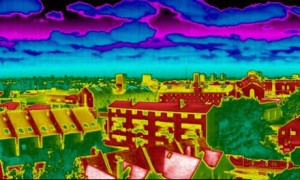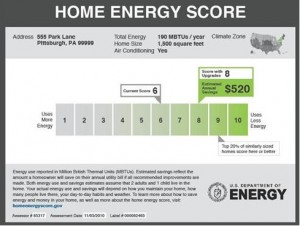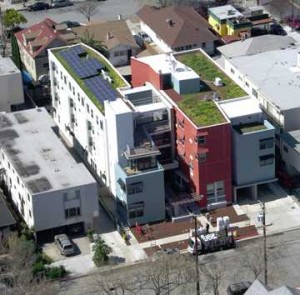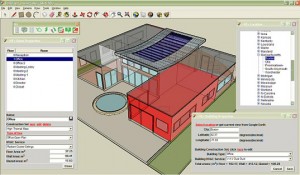Posts Tagged sustainable
86% of Building Construction Expenditures Relate to Renovation of Existing Buildings
Posted by Jim Foster in BIM, Built Environment, economic trends, Energy Analysis, Green, Sustainable Retrofits on February 18, 2013
 “As ASHRAE President Gordon V.R. Holness noted in the ASHRAE Journal, “Approximately 86% of building construction expenditures relate to renovation of existing buildings, not to new construction.” Holness estimated that “over the next 30 years about 150 billion sf of existing buildings (roughly half of the entire building stock in the United States) will need to be renovated.” Historically, new construction only adds about 2% annually to the U.S. commercial building stock, so the real opportunities for reducing operating costs must be found in building retrofit and renovation.” – Glumac Blog.
“As ASHRAE President Gordon V.R. Holness noted in the ASHRAE Journal, “Approximately 86% of building construction expenditures relate to renovation of existing buildings, not to new construction.” Holness estimated that “over the next 30 years about 150 billion sf of existing buildings (roughly half of the entire building stock in the United States) will need to be renovated.” Historically, new construction only adds about 2% annually to the U.S. commercial building stock, so the real opportunities for reducing operating costs must be found in building retrofit and renovation.” – Glumac Blog.
Buildings are the major source of global demand for energy and materials that produce by-product greenhouse gases (GHG). Slowing the growth rate of GHG emissions and then reversing it is the key to addressing climate change and keeping global average temperature below 2°C above pre-industrial levels.
To accomplish this, Architecture 2030 issued The 2030 Challenge asking the global architecture and building community to adopt the following targets:
- All new buildings, developments and major renovations shall be designed to meet a fossil fuel, GHG-emitting, energy consumption performance standard of 60% below the regional (or country) average/median for that building type.
- At a minimum, an equal amount of existing building area shall be renovated annually to meet a fossil fuel, GHG-emitting, energy consumption performance standard of 60% of the regional (or country) average for that building type.
- The fossil fuel reduction standard for all new buildings and major renovations shall be increased to:
- 70% in 2015
- 80% in 2020
- 90% in 2025
- Carbon-neutral in 2030 (using no fossil fuel GHG emitting energy to operate).
These targets may be accomplished by implementing innovative sustainable design strategies, generating on-site renewable power and/or purchasing (20% maximum) renewable energy.
Please visit Frequently Asked Questions section for more in-depth information on the 2030 Challenge.
******
*Note: This was stated in the January 2008 Edition of the ASHRAE Journal. When we polled permitting for Boston, we found 75% for construction in Existing Buildings. 25% New.
Building Energy Analysis : A smorgasbord
Posted by Jim Foster in As Builts, Autodesk, BIM, Energy Analysis, Energy Modeling on April 11, 2012
 This is the case the more I learn about it, the less I know. As energy analysis picks up as a real tool in the trades, not just for sustainable retrofits, but to provide the data for financing as well and people working it from combing demographic information with utilities, to engineers, and beyond the amount of tools out there starts to become staggering…and I am sure I will be missing plenty. But half of this excercise is to get input from anyone reading this to what they are using and why. And am encouraging smack talk to why one is better than another. What follows is a completely non-exhaustive list of stuff I’ve been running into and in no particular order. For a more exhaustive list without editorial comments the DOE (Department of Energy) maintains this List.
This is the case the more I learn about it, the less I know. As energy analysis picks up as a real tool in the trades, not just for sustainable retrofits, but to provide the data for financing as well and people working it from combing demographic information with utilities, to engineers, and beyond the amount of tools out there starts to become staggering…and I am sure I will be missing plenty. But half of this excercise is to get input from anyone reading this to what they are using and why. And am encouraging smack talk to why one is better than another. What follows is a completely non-exhaustive list of stuff I’ve been running into and in no particular order. For a more exhaustive list without editorial comments the DOE (Department of Energy) maintains this List.
- EQuest – Straight out of the DOE, and while their website looks like it was designed in 1998, the claim is “Imagine a building energy simulation tool comprehensive enough to be useful to ALL design team members, yet so intuitive ANY design team member could use it” And I know people out there using it.
- BEopt – Straight out of NREL (National Renewable Energy Laboratory) – Now this seems to have some limitations and uses the DOE 2.2 engine, just as eQuest does however, one thing that popped out is the fact that you cannot call out different wall types or change sill heights to windows, which seems very limiting, yet, people are out there using it.
- EnergyPlus : ” is a whole building energy simulation program that engineers, architects, and researchers use to model energy and water use in buildings”
- The Autodesk Family
- Green Building Studio – This a web based service that allows for a variety of analysis including:
- Whole Building Energy Analysis
- Carbon Emissions : Footprint
- Weather Analysis
- Design Alternatives
- Water Usage
- Energy Star Scoring
- GBS uses gbXML and is interoperable with Revit and….yes the DOE 2.2 Engine.
- Ecotect : How this is different than GBS, I don’t know, but if you buy Ecotect you get GBS along with it..but both have similar claims.
- Vasari : More energy analysis but at the design concept stage
- Google : Sketch Up Family
- IES Plug In – Allows you to apply materials onto a Sketch Up model for import into an IES tool
- Energy Plus Open Studio Plug In – All the EnergyPlus option through your SketchUp model
- GreenSpace Modeler : Allows you to apply gbmxl textures to a sketchup model for import into a gbmxl tool for analysis like Green Building Studio
An excellent resource I found through WBDG is the a summary of Energy Analysis Tools, including DOE 2.2, BLAST, EnergyPlus, and the like. Plus there is a whole list of BLCCs (Building Lifecycle Cost) Programs.
I guess the point is just when you think BIM is going to solve everything with a push button, no matter which ecosphere you live in, be it Autodesk, Archicad, etc. there are tool sets out there, and more importantly ‘free’ tool sets out there that get a lot of play. What worksflows and tools are you using for building / energy analysis?
Obama Administration Boosts Retrofits : Biden Announces Fed Program
Posted by Jim Foster in BIM, Built Environment, Sustainable Retrofits on November 12, 2010
 Am I calling it or what? As reported by Martin LaMonica on CNET and the Steven Thomma of the Miami Herald Vice President Joe Biden with US Department of Energy Secretary Steven Chu on Tuesday unveiled a new federal program to make it easier for Americans to make their homes more energy efficient, saying it will help people save money and create new jobs for contractors.
Am I calling it or what? As reported by Martin LaMonica on CNET and the Steven Thomma of the Miami Herald Vice President Joe Biden with US Department of Energy Secretary Steven Chu on Tuesday unveiled a new federal program to make it easier for Americans to make their homes more energy efficient, saying it will help people save money and create new jobs for contractors.Excerpts for the release below:
“The initiatives announced today are putting the Recovery Through Retrofit report’s recommendations into action – giving American families the tools they need to invest in home energy upgrades.” said Vice President Biden. “Together, these programs will grow the home retrofit industry and help middle class families save money and energy.”
“The Home Energy Score will help make energy efficiency easy and accessible to America’s families by providing them with straightforward and reliable information about their homes’ energy performance and specific, cost-effective energy efficiency improvements that will save them money on their monthly energy bills,” said Secretary Chu.
Under this voluntary program, trained and certified contractors will use a standardized assessment tool developed by DOE and Lawrence Berkeley National Laboratory to quickly evaluate a home and generate useful, actionable information for homeowners or prospective homebuyers. With only about 40 inputs required, the Home Energy Scoring Tool lets a contractor evaluate a home’s energy assets, like its heating and cooling systems, insulation levels and more, in generally less than an hour. That means a homeowner can see how their home’s systems score, regardless of whether a particular homeowner takes long or short showers or keeps their thermostat set high or low.
The following states and municipalities are participating in the pilot program: Charlottesville, Virginia; Allegheny County, Pennsylvania; Cape Cod and Martha’s Vineyard, Massachusetts; Minnesota; Omaha and Lincoln, Nebraska; Indiana; Portland, Oregon; South Carolina; Texas; and Eagle County, Colorado. Learn more about each of the testing locations along with details on how to participate in the Home Energy Score program.
Consumers can apply for up to $25,000 in PowerSaver loans through the U.S. Department of Housing and Urban Development, which expects that 24,000 homes will qualify during a two-year pilot program, according to USA Today.
This home energy retrofit program follows a $5 billion weatherization investment that was part of the stimulus package last year. Another effort is Home Star, nicknamed Cash for Caulkers, which would provide rebates to consumers for investing in energy efficiency retrofits.
Read more: http://news.cnet.com/8301-11128_3-20022184-54.html#ixzz155UA7FTa
How does this effect BIM users/developers, etc.?
Commercial deployment will be huge and has more robust documentation and reporting needs, plus these firms getting into it will need to have better tools, etc as the race begins to fill these needs and to differentiate themselves from competition, imagine a 3D BIM model with all the reporting built into it. I have to imagine the plug ins are already under development. Additionally, did you notice the certification needs recommended for this. Strap it on, let’s get back to work.
Green BIM : Everybody’s Doing It
Posted by Jim Foster in BIM, Green on October 25, 2010
 As reported recently in the Wall Street Journal, ‘Turning Consumers Green‘ the best tactic is peer pressure. From reducing plastic bag use to turning off the shower. You might ask, who’s going to pressure me in the shower. Fair enough, but this is in a locker room setting where they stated when a sign was posted to turn off the shower when soaping there was 6% compliance but if there was a plant, as in a person who they planted there to turn off water when they soaped, compliance rocketed to 47%. (Sidebar: How do they advertise this job and who applies or volunteers for that particular task.) But how does this impact you rather than reemphasizing people are sheep? Well if you can identity a trend that gains this kind of traction because of the peer pressure you don’t have to look far out into our industry before you find BIM and the emerging strength of Green BIM and rapid energy modeling. In a recent MCGraw Hill Smart Market Report, Green BIM the cited the growth of sustainable retrofits that are green will increase from 5-9% currently to 20-30% in 2014. Huge growth in energy simulation is expected in this market with the top 3 being:
As reported recently in the Wall Street Journal, ‘Turning Consumers Green‘ the best tactic is peer pressure. From reducing plastic bag use to turning off the shower. You might ask, who’s going to pressure me in the shower. Fair enough, but this is in a locker room setting where they stated when a sign was posted to turn off the shower when soaping there was 6% compliance but if there was a plant, as in a person who they planted there to turn off water when they soaped, compliance rocketed to 47%. (Sidebar: How do they advertise this job and who applies or volunteers for that particular task.) But how does this impact you rather than reemphasizing people are sheep? Well if you can identity a trend that gains this kind of traction because of the peer pressure you don’t have to look far out into our industry before you find BIM and the emerging strength of Green BIM and rapid energy modeling. In a recent MCGraw Hill Smart Market Report, Green BIM the cited the growth of sustainable retrofits that are green will increase from 5-9% currently to 20-30% in 2014. Huge growth in energy simulation is expected in this market with the top 3 being:
- Whole Building Energy Use
- Lighting and Day Lighting
- Energy Code Compliance
This type of analysis is right in BIM’s wheelhouse as seen in Revit CEA. However, one of the biggest issues still remains software integration, that is one model, many uses rather than everyone building their own model for their own uses. So look for more companies trying to either build functionality on top of existing platforms or creating translation or integration tools.
Look for Green to expand. It’s not for just Organic Folks eating Birkenstocks at their local markets as it is starting to make too much sense. For example, Casa Feliz Apartments in San Jose and as reported by Robbie Whelan in the Wall Street Journal, ‘utilized bamboo floors, linseed oil based linoleum and ergonomic chairs in the lobby made from sustainability farmed wood.’ Addtionally,
Casa Feliz is one of a growing number of affordable-housing projects nationwide that have been built “green”—that is, with nontoxic materials, highly energy-efficient appliances, and features such as green roofs and solar panels. Thanks to tax credits designed to attract private capital and aggressive cost-cutting on other construction features, affordable-housing developers are embracing eco-friendly building features that were once the purview of high-minded designers and wealthy developers with money to spare.
MetLife Inc., the big New York-based insurance company, is one of those investors. Matt Sheedy, who invests funds from MetLife’s $325 billion general account, says MetLife and other large institutional investors are eager to invest in green affordable-housing projects because they have a safer risk profile than more traditional housing projects.
So either get caught by the wave, or build your boat out of sustainable wood, hoist your hemp sail and get going. Your firm needs a Green BIM strategy.
Sustainable Retrofits Projected to be $400b US Market by 2030
Posted by Jim Foster in Built Environment, Green, New Technologies, Sustainable Retrofits on August 27, 2010
 I had a conversation yesterday with as Program Manager from Autodesk who was looking into implementing workflows utilizing Autodesk Products to produce energy analysis for existing buildings. He had seen one of our many fantastic videos for PKNail, okay we have two homegrown videos, but our effort in capturing the built environment dovetails nicely with this effort. And while I have commented many times on the sustainable retrofit market I had not seen a number placed on it but Autodesk posted a number on their web site. If you are not intending to make the jump you can read some of their conclusions below.
I had a conversation yesterday with as Program Manager from Autodesk who was looking into implementing workflows utilizing Autodesk Products to produce energy analysis for existing buildings. He had seen one of our many fantastic videos for PKNail, okay we have two homegrown videos, but our effort in capturing the built environment dovetails nicely with this effort. And while I have commented many times on the sustainable retrofit market I had not seen a number placed on it but Autodesk posted a number on their web site. If you are not intending to make the jump you can read some of their conclusions below.
Buildings are key to achieving climate stabilization, representing roughly 40% of global energy consumption and 25% of global carbon emissions. In addition, energy efficiency retrofits represent a massive latent market, projected to reach an estimated worth of $400 billion by 2030 in the U.S. alone. To respond to these twin environmental and market demands at scale and speed, the building industry needs to respond quickly and cost-effectively.
Our research suggests that rapid energy modeling enables building energy assessments with a smaller budget and shorter time frame, and can thereby help increase the number of existing buildings that undergo assessment and energy upgrades. We expect property owners and managers, home buyers, tenants and landlords, designers and architects, auditors, and energy consultants to benefit from such a workflow.
Included in this effort is Revit CEA (Conceptual Energy Analysis) that allows the user, after putting parameters in place, to use a cloud computing enironment, that is send it out for computation, to perform the calculations using Green Building Studio as the back end but making it transparent to the user. What I like about this effort is that I am not required to fire up or even know Green Building Studio to do the energy analysis, the export and data exchange, done in gbXML is done seemlessly and I get the report.
But back to the original premise which is getting existing buildings into a format that you can perform this and Autodesk has developed a workflow to help, and while this is excellent I would also argue for PKNail’s place in the workflow as measuring and building in the environment you are going to model and analyze reduces a couple of steps and amount of software you need to know. I don’t argue it should be the only tool just that it deserves a place on the shelf.
Department of Energy (DOE) Launches New Blog : Energy Blog : Yawn? : BIM
Posted by Jim Foster in BIM, Energy Analysis on July 27, 2010
 As reported by Katherine Tweed from GreenTech Media and picked up by Wired the DOE Launched a new blog. (Man, this new media everybody ‘borrowing’ and ‘sharing’ content gets tough to footnote). Alone, generally, this should be met with a collective YAWN. However, as a thread of the whole fabric it adds strength to the perception and reality of the move to a sustainable future and the real investment that is happening around it. And get this from a post on July 23.
As reported by Katherine Tweed from GreenTech Media and picked up by Wired the DOE Launched a new blog. (Man, this new media everybody ‘borrowing’ and ‘sharing’ content gets tough to footnote). Alone, generally, this should be met with a collective YAWN. However, as a thread of the whole fabric it adds strength to the perception and reality of the move to a sustainable future and the real investment that is happening around it. And get this from a post on July 23.
…Cindy Regnier (from the) Lawrence Berkeley National Laboratory… works on several projects, including two that are Recovery Act-funded: the new User Facility for Low-Energy Integrated Building Systems test bed and the Commercial Building Partnerships initiative)…is helping to select dozens of new and existing commercial building projects from around the country to receive technical assistance from the national labs to achieve 50% energy savings in new construction and 30% in existing buildings. Each building will have energy-savings measures validated and evaluated from energy and cost standpoints, all with the goal of developing and promoting energy efficiency measures that can be easily deployed throughout the industry.
So not completely dull, and if you keep an eye on this project you might find out where the government might focus more efforts for existing buildings, techniques, tools, products, etc. For example, I wonder what technologies and assistance Ms. Weigner might be deploying herself. Cindy give me a shout.
The blog itself is available here
Using BIM for Sustainable Design
Posted by Jim Foster in BIM, Sustainable Retrofits on July 26, 2010
 Good article in Architecture Week titled, strangely enough, Using BIM for Sustainable Design, I guess we’re getting that horse out of the stable again, but this is it. Like AARA funds and the stimulus package put every paver and asphalt layer in the US back to work, sustainable design and retrofits are and will be it. Eddy Kryiegel, the author, goes on to elaborate the ease that option analysis and energy modeling that comes with BIM.
Good article in Architecture Week titled, strangely enough, Using BIM for Sustainable Design, I guess we’re getting that horse out of the stable again, but this is it. Like AARA funds and the stimulus package put every paver and asphalt layer in the US back to work, sustainable design and retrofits are and will be it. Eddy Kryiegel, the author, goes on to elaborate the ease that option analysis and energy modeling that comes with BIM.
In the case of energy modeling and its relationship to BIM, there are three primary steps involved: modeling the building geometry, adding building loads, and performing the analysis.
If you compare the time it takes to perform each of these steps for the same building type across a variety of analysis packages, you will see very similar results. During years of integrated practice, I have found that more than 50 percent of the overall time needed to perform an energy analysis is consumed by modeling building geometry.
Adding building loads accounts for about 35 percent, followed by less than 15 percent to perform the actual analysis. By simply being able to reuse the model geometry and transfer the building design from the BIM model to the energy model, we can reduce the time needed to run an energy model by almost half.
The traditional process of energy modeling within our own office typically takes a couple weeks. Using the workflow established with BIM, we can now perform some types of energy analysis in half the time, do twice as many as before, or make energy analysis available to projects that would normally not have the fee to support the endeavor.
A) If a project is started in BIM more services can be offered whereas they were too expensive the traditional way, and B) with option analysis you can find ways to make your building more efficient, demonstrate that with positive ROIs and have the analysis and design pay for itself. Just keeps on getting more compelling, like the Lebron laugh-a-lympics televised special, no strike that, like Lindsey..strike that, like having your cake and eating it too.
Rapid Energy Modeling : Sustainable Retrofits : The Market, Tools & Techniques : BIM
Posted by Jim Foster in BIM, Built Environment, Green, Laser BIM, Point to Point Laser Technology on May 19, 2010
There is a virtuous circle afoot and it’s not just how you spin social networking to acquire traffic it is sustainable retrofits and if you wonder what’s the next big thing, what gets us out of this economic tailspin, or at least malaise too many data points are starting to point in the sustainable retrofit direction. ARRA (American Relief and Recovery Act) money points that way, the President speaks about green jobs, Autodesk is hyping it and I am being constantly contacted from firms wanting to use our technology, PointKnown , to augment their green building practices. And the best thing about it, it makes sense, unlike pets.com which use to ship dogfood to you via fedex.
Here are some stats, most of them gleaned from an Autodesk Paper, (from the I read it so you don’t have to category).
-
Approximately 75 percent of buildings globally will be either new or have undergone significant renovation by 2035 (1)
-
About 150 billion square feet of existing buildings (roughly half of the entire building stock in the United States) will need to be renovated over the next 30 years. (2)
-
A recent analysis estimates that green building retrofits in the United States represent a $400B market in the next 20 years. (3)
(1) http://www.architecture2030.org/ (2009)
(2) American Institute of Architects (AIA) COTE (2009), Ecology and Design: Ecological Literacy in Architecture Education.
(3) Pike Research (2009), “Energy Efficiency Retrofits for Commercial and Public Buildings,” Executive Summary.
That means work up and down the line from surveying and modeling buildings, through energy analysis, the design process through constrcution. But the reason it makes most sense is that there is viable and real ROI not just from the environmental benefit but also from the energy savings. Autodesk’s argument, while self-serving, provides some valid points.
• Supplement energy benchmarking by providing numerous design alternatives to users.
• Democratize the energy and carbon footprinting process by making it accessible to a wider audience of practitioners.
• Make modeling faster, cheaper, and more likely to be used.
 Autodesk’s work flow utilizes image modeler to be imported into Revit for modeling. While personally am not a big fan of introducing another piece of software into the workflow I can see where some people will be more comfortable using photos, etc. to create geometries. PointKnown takes a different tact in utilizing PPLT (Point to Point Technology) to define objects directly into a Revit work station. That way a user can further leverage their existing software, draft in a familiar platform, and leave with a dimensionally correct model. At the end of it you can choose to leave the generic walls, windows, etc. in place for gbXML export, or energy analysis, or begin the process into defining the elements. Your choice, but you have a dimensionally correct model in the field, with no intermediate translation step. Now to get technical PPLT is best used for planar surfaces that have minimal variation, that is a wall, that’s straight, but then again typical conditions dictate most surfaces of walls be straight or are at least intended to be. And for energy analysis this could be a powerful tool to jump start the modeling, and actually make it ‘Rapid’
Autodesk’s work flow utilizes image modeler to be imported into Revit for modeling. While personally am not a big fan of introducing another piece of software into the workflow I can see where some people will be more comfortable using photos, etc. to create geometries. PointKnown takes a different tact in utilizing PPLT (Point to Point Technology) to define objects directly into a Revit work station. That way a user can further leverage their existing software, draft in a familiar platform, and leave with a dimensionally correct model. At the end of it you can choose to leave the generic walls, windows, etc. in place for gbXML export, or energy analysis, or begin the process into defining the elements. Your choice, but you have a dimensionally correct model in the field, with no intermediate translation step. Now to get technical PPLT is best used for planar surfaces that have minimal variation, that is a wall, that’s straight, but then again typical conditions dictate most surfaces of walls be straight or are at least intended to be. And for energy analysis this could be a powerful tool to jump start the modeling, and actually make it ‘Rapid’
Government Green : Sustainable Retrofits Redux : #BIM #AIA #LEED
Posted by Jim Foster in BIM, Built Environment, Energy Analysis, Green, LEED on March 11, 2010
So post yesterday was how I and I am sure everyone is starting get bombarded with this message so today in my inbox from USGBC I get these stats.
- Much of the $787 billion in federal stimulus money supports green retrofits of publicly owned buildings at the local, state and federal levels.
- The federal government alone owns and operates some 500,000 buildings.
- The federal government has a 28 percent greenhouse gas reduction target for federal operations by 2020.
- 30 percent of all LEED projects are government-owned
And they are holding the USGBC 2010 Federal Summit, May 18-19 2010 in DC
Next thing I will look into are the top 10 items in sustainable retrofits. As always input welcome.
Repeat after me…Sustainable Retrofits : #BIM #AIA #LEED
Posted by Jim Foster in Adoption, BIM, Built Environment, economic trends, Energy Analysis, Green on March 10, 2010
Within the last week I have been called, e-mailed and gone out to discuss sustainable retrofits. The logic for it seems unassailable and I included some quick stats at the bottom of the posting. However, as with the rise of virtual construction this is starting to make more sense to most that this is a real economic opportunity. What’s the cause, not sure if it’s the natural progression as companies look for opportunities in this environment, a truck load of AARA and TARP funds have hit, the Clinton Climate Initiative is creating traction, or a lot of hemp wearing hippies have hit the boardroom, however I believe the first penguins have slid down the ice and the rest of the waddle / rookery / herd is starting to follow.
Additionally, more hard data points are becoming available to assist. The Empire State Building has started a massive $500 million renovation and hopes to reduce its energy cost up to 38% annually or $4.4 Million. ‘Wait, you say’ Even I know what looks like to be a 100 year payback seems insane, why spend the money.’ If you look more closely and as they point out at the website that additional improvements on already planned upgrades cost $13.2 million, so $13.2 million yields the saving and payback in less than 4 years. The Chicago Mercantile Mart and its 4.2 million SF of showrooms, offices and and tradeshow space earned LEED -EB (Existing Building) Silver. While a video of Kong climbing the Empire State could be more compelling I included the promotional video as possibly more informing.
Inside the video at about 2:05 they talk about energy modeling. I wish they included what they used to model it, but if we start talking about scenario analysis and ROI we start talking about BIM again, and various companion products like EcoTect and IES. One of the bigger points made is that the time to do these things is by piggybacking on top of already planned improvements. But from low flush toilets, to new digital controls, reglazing windows, to chiller retrofits new ROI models are inviting and this strategy/offering has to be, absolutely, be in your quiver.
Some data points I found while researching this post.
Excerpted comments from President Obama speaking at the Brookings Institute are as follows:
Speaking about AARA funds the President said “is put Americans back to work doing the work America needs done, doubling our capacity in renewable energy’
‘Clean energy projects will all be ramping up in the months ahead’
‘I’m calling on Congress to consider a new program to provide incentives for consumers who retrofit their homes to become more energy efficient, which we know creates jobs, saves money for families, and reduces the pollution that threatens our environment. And I’m proposing that we expand select Recovery Act initiatives to promote energy efficiency and clean energy jobs which have proven particularly popular and effective.’ Full Transcript Available Here
Buildings and Climate Change – Quick Stats:
- Buildings Account for 38% of CO2 emissions in the United States —more than either the transportation or industrial sectors
- Over the next 25 years, CO2 emissions from buildings are projected to grow faster than any other sector, with emissions from commercial buildings projected to grow the fastest—1.8% a year through 2030
- Buildings consume 70% of the electricity load in the U.S.
- Buildings have a lifespan of 50-100 years during which they continually consume energy and produce CO2 emissions. If half of new commercial buildings were built to use 50% less energy, it would save over 6 million metric tons of CO2 annually for the life of the buildings—the equivalent of taking more than 1 million cars off the road every year
- The U.S. population and economy are projected to grow significantly over the coming decades, increasing the need for new buildings – to meet this demand, approximately 15 million new buildings are projected to be constructed by 2015
- Building green is one of the best strategies for meeting the challenge of climate change because the technology to make substantial reductions in energy and CO2 emissions already exists. The average LEED® certified building uses 32% less electricity and saves 350 metric tons of CO2 emissions annually
- Modest investments in energy-saving and other climate-friendly technologies can yield buildings and communities that are environmentally responsible, profitable and healthier places to live and work, and that contribute to reducing CO2 emissions
Source: USGBC (US Green Building Council) and ASHRAE ( American Society of Heating, Refrigerating and Air Conditioning Engineers), the AIA, IESNA (Illuminating Engineering Society of North America) and the DOE.


